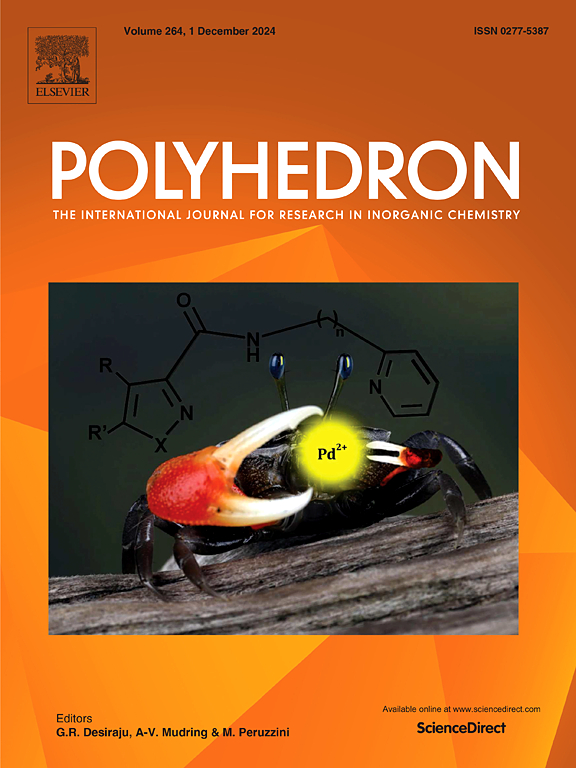分光光度法测定新型功能性席夫碱及其外周CoII和CuII酞菁在阿尔茨海默病治疗中的体外胆碱能酶抑制电位
IF 2.4
3区 化学
Q2 CHEMISTRY, INORGANIC & NUCLEAR
引用次数: 0
摘要
由于神经退行性疾病,包括阿尔茨海默病(AD),胆碱能神经元和胆碱能系统的突触前指标逐渐消失,阿尔茨海默病是痴呆症最常见的原因之一。通过抑制乙酰胆碱酯酶(AChE)从而降低乙酰胆碱水解速率,可以抵消这些影响。具有可逆抑制作用的抗胆碱酯酶药物因此被用于治疗神经退行性疾病。本文研究了希夫碱化合物(Schiffb.OH/CN)及其钴(Schiffb.CoPc)和铜(Schiffb.CuPc)酞菁化合物的合成,并对其体外胆碱能酶抑制电位进行了分光光度分析。总的来说,与其他化合物相比,研究人员发现,Schiffb。CuPc是最有效的抑制剂。此外,其结果与阳性对照加兰他明(26.17±0.52µM)具有统计学上的可比性。然而,在检测的浓度下,表明化合物对BuChE没有作用。根据这项研究,这些化合物可能对乙酰胆碱酯有选择性。本文章由计算机程序翻译,如有差异,请以英文原文为准。

Spectrophotometric in vitro cholinergic enzyme inhibitory potentials of novel functional Schiff bases and their peripheral CoII and CuII phthalocyanines in the treatment of Alzheimer’s disease
Cholinergic neurons and presynaptic indicators of the cholinergic system gradually disappear as a result of neurodegenerative disorders, including Alzheimer’s disease (AD), one of the most prevalent causes of dementia. By inhibiting acetylcholinesterase (AChE) and thus reducing the rate of acetylcholine hydrolysis, these effects can be counteracted. Anticholinesterase medications that have reversible inhibitory effects are therefore used to treat neurodegenerative illnesses. This work involved the synthesis of Schiff base compounds (Schiffb.OH/CN) and their cobalt (Schiffb.CoPc) and copper (Schiffb.CuPc) phthalocyanine compounds, as well as spectrophotometric analysis of their in vitro cholinergic enzyme inhibitory potentials. Overall, it was found that, when compared to the other compounds examined, Schiffb.CuPc was the most potent inhibitor. Furthermore, it exhibited statistically comparable results to the positive control, galantamine (26.17 ± 0.52 µM). However, at the concentrations examined, it was shown that the compounds exhibited no action against BuChE. The compounds may be selective for AChE, according to this research.
求助全文
通过发布文献求助,成功后即可免费获取论文全文。
去求助
来源期刊

Polyhedron
化学-晶体学
CiteScore
4.90
自引率
7.70%
发文量
515
审稿时长
2 months
期刊介绍:
Polyhedron publishes original, fundamental, experimental and theoretical work of the highest quality in all the major areas of inorganic chemistry. This includes synthetic chemistry, coordination chemistry, organometallic chemistry, bioinorganic chemistry, and solid-state and materials chemistry.
Papers should be significant pieces of work, and all new compounds must be appropriately characterized. The inclusion of single-crystal X-ray structural data is strongly encouraged, but papers reporting only the X-ray structure determination of a single compound will usually not be considered. Papers on solid-state or materials chemistry will be expected to have a significant molecular chemistry component (such as the synthesis and characterization of the molecular precursors and/or a systematic study of the use of different precursors or reaction conditions) or demonstrate a cutting-edge application (for example inorganic materials for energy applications). Papers dealing only with stability constants are not considered.
 求助内容:
求助内容: 应助结果提醒方式:
应助结果提醒方式:


